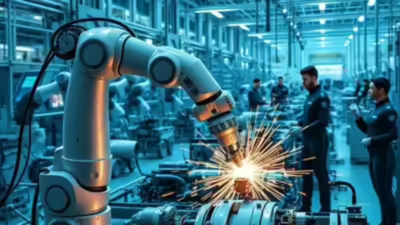US manufacturing falters despite policy boost: Donald Trump’s tariffs and Biden’s subsidies fail to lift sector; jobs, output remain stuck in post-pandemic rut

US manufacturing is showing persistent signs of stagnation despite a policy push from both political sides — with President Donald Trump deploying steep tariffs and former President Joe Biden previously handing out subsidies — to shore up domestic industry. Job losses and tepid production data point to a sector still waiting for momentum to return.Factories in the US cut 7,000 jobs in June, according to the Labor Department, marking the second straight month of declines. Manufacturing employment is now set to fall for a third consecutive year. Activity also continued to contract in June, with the Institute for Supply Management (ISM) reporting that the sector has shrunk in 30 of the past 32 months since October 2022.The analysis highlights the limited impact of both the Biden-era factory investment boom and the Trump administration’s aggressive tariff regime, reported by AP. “The past three years have been a real slog for manufacturing,” said Eric Hagopian, CEO of Pilot Precision Products, a Massachusetts-based industrial tools maker. “We didn’t get destroyed like in 2008, but we’ve been in this stagnant, sort of stationary environment.”The slowdown has been driven by several factors, including inflationary pressures that spiked following the post-COVID recovery and the Federal Reserve’s sharp interest rate hikes in 2022 and 2023. Though Biden’s clean energy and chip subsidies sparked a surge in factory construction between 2021 and 2024, investments have since slowed after Trump returned to power and Congress reversed many green energy incentives.Mark Zandi, chief economist at Moody’s Analytics, warned that “manufacturing production will continue to flatline,” adding that employment in the sector is likely to shrink further in the coming year.Trump, meanwhile, is pursuing protectionist policies to encourage domestic manufacturing. The administration has imposed tariffs of 50% on steel and aluminum, 25% on autos and parts, and 10% on a range of other imports. While the levies offer some companies a pricing edge, they also raise costs on imported materials essential to US producers.“For some bids, the tariff helps us stay competitive,” said Chris Zuzick, VP at Waukesha Metal Products in Wisconsin, AP quoted. But steel prices, buoyed by the protectionist policy, have soared — reaching $960 per metric ton in the US, more than double the $440 world average as of June 23, according to SteelBenchmarker.Despite the high duties, firms like Pilot Precision still source steel from France and Austria — even after paying tariffs — because of price and quality dynamics.Further complicating matters is the lack of clarity around policy. Trump has repeatedly delayed and revised tariff schedules, leaving manufacturers in limbo. “Customers do not want to make commitments in the wake of massive tariff uncertainty,” an ISM survey respondent from the fabricated metal products industry noted. A computer hardware firm added, “The situation remains too volatile to firmly put such plans into place.”The recent slowdown may also reflect a reversion to pre-pandemic norms. After losing nearly 1.4 million jobs in early 2020, factories surged during the COVID-driven goods boom, adding 379,000 jobs in 2021 and 357,000 in 2022. But hiring then plateaued in 2023 and has since reversed.As of June, factory payrolls stood at 12.75 million — almost unchanged from the 12.74 million recorded in February 2020. “It’s a long, strange trip to get back to where we started,” said Jared Bernstein, chair of Biden’s Council of Economic Advisers.While manufacturers wait for clearer signals from the Trump administration’s upcoming “One Big Beautiful Bill,” many remain cautious. Hagopian is hopeful that targeted tax breaks might help, and Zuzick echoed that it’s too soon to judge the tariff impact: “Manufacturing doesn’t turn on a dime.”With policy flip-flops, cost pressure and weak demand all in play, most factories are keeping hiring and investment plans on hold. “Everyone,” Zuzick said, “is kind of just waiting for the new normal.”




